
Order: PROCELLARIIFORMES
Family: PROCELLARIIDAE
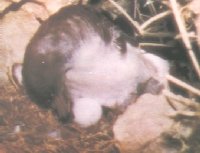 Calonectris
diomedea diomedea (Scopoli)
Calonectris
diomedea diomedea (Scopoli)
Cory's Mediterranean Shearwater
maltese: Ciefa
The Cory's Shearwater is one of the largest of the shearwaters being
45 cm in length and has a wing span of about 110 cm. Upperparts are blotchy
greyish brown with much darker flight and tail feathers. Underparts are
white. It has webbed feet and a strong bill with exterior tubular nostrils
and a hooked tip. It breeds in scattered colonies along the southern and
western sea cliffs of Malta and Gozo and also on Filfla. The largest colony
is that at Ta' Cenc Cliffs (Gozo). It nests in natural burrows and crevices
where a single chalky white egg, slightly larger and more elongated thanthat
of a hen, is laid usually on bare ground between mid-May and mid-June.
Both sexes incubate, taking turns of several days. Incubation lasts up
to seven weeks. When the young hatches, it is covered by a very thick grey
down and is fed by both parents which visit it at night. The colonies are
deserted by late October. Shearwaters, whose sexes are similar in plumage,
are pelagic and only come to land during their long breeding season. They
visit their colonies at night when they usually utter loud weird cries
and grunts especially during their courting season.
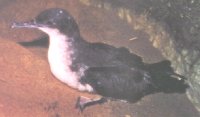 Puffinus
puffinus yelkouan (Acerbi)
Puffinus
puffinus yelkouan (Acerbi)
Manx Levantine Shearwater
maltese: Garnija
The Manx Shearwater (35 cm) is a smaller version of the Cory's but
has black upperparts contrasting with pure white underparts. Its general
appearance, habits and behaviour are like those of the Cory's Shearwater.
However, the single chalky white egg, which is similar in size and shape
to a hen's, is laid by the end of March or early April, and the colonies
are already deserted by the end of July. It breeds in scattered colonies
along most sea cliffs in reasonably deep caverns. on Filfla it thrives
under loose boulders and in deep burrows. Like the Cory's, the Manx Shearwater
feeds on fish which are caught from just below the surface.
Family: HYDROBATIDAE
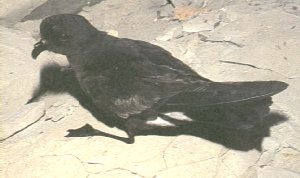 Hydrobates
pelagicus (Linnaeus)
Hydrobates
pelagicus (Linnaeus)
Storm Petrel
maltese: Kangu ta' Filfla
The Storm Petrel is 15 cm in length and has a wing span of 35 cm.
It is the smallest European sea-bird, slightly larger than a sparrow but
has much longer wings. Like shearwaters, it is pelagic in habits. It is
sooty black all over, including the bill and webbed feet, with a white
rump. It breeds in large colonies on Filfla and Gozo. There it lays a single,
relatively large egg the size of a pigeon's, on bare ground in holes, crevices
and burrows. The egg which is white sometimes having very fine brown spots
round the thicker end, is laid between mid-May and the end of June. Incubation
takes about six weeks and is carried out by both sexes. The young have
a cover of grey down which is replaced by feathers during its stay of about
nine weeks at the nest site. Like the shearwaters, when the young leaves
the colony, it resembles the adults in plumage. Both the adults and young
vomit a nasty-smelling oily liquid when danger threatens. Before taking
its first flight after it is deserted by its parents, the young frequently
ventures out at night near the entrance of its burrow to exercise its wings.
The Storm Petrel has a bat-like flight and though one may see it from ships
at sea, it is seldom seen during the day near the coast. It feeds on plankton
and small fish.
Order: ACCIPITRIFORMES
Family: FALCONIDAE
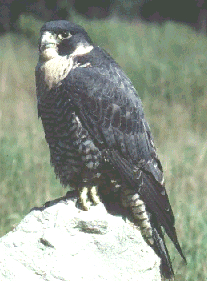 Falco
peregrinus brookei Sharpe
Falco
peregrinus brookei Sharpe
Mediterranean Lesser Peregrine
maltese: Bies
The Peregrine (38-48 cm) has dark bluish grey underparts with a
bluish black head and lobed moustaches. Its white underparts are narrowly
barred with black. The female is larger and darker than the male. The young
is dark brown above with streaked buffish underparts. It has long, pointed
wings and a long tail. It is well known for its strength and speed, and
it stoops on its prey in a headlong dive with half-closed wings. One or
two resident pairs used to breed in the south-westerly cliffs. The last
known breeding pair were killed in 1979 at Ta' Cenc. Two to three eggs
are usually laid in March in a hole or a scrape on an inaccesible ledge
on a sea-cliff. The eggs are almost entirely mottled with several shades
of reddish brown. After four weeks incubation, which is mainly carried
out by the female, the young hatch. They are covered with a creamy white
down. They leave the nest after about five weeks.
 Falco
tinnunculus tinnunculus Linnaeus
Falco
tinnunculus tinnunculus Linnaeus
Kestrel
maltese: Spanjulett, Seqer ahmar
The Kestrel is a common passage migrant in spring and autumn and
a few occur throughout winter. Very few pairs attempt to breed, but due
to shooting they rarely succeed. The kestrel was recorded to be a breeding
resident 1969. The male has a grey head, rump and tail (the latter
with a dark band) and a chestnut back with black spots. Underparts are
buff with dark streaks. Females and immatures are brown above with dark
narrow bars on the back and tail. Generally, the site is a crag in a cliff
where about four eggs on material consisting of twigs, straw and feathers.
The eggs are laid in late April or early May and have an overall covering
of dark red-brown markings. The Kestrel seeks prey by hovering above the
ground. Its food consists of small rodents, lizards and large insects.
Order: GALLIFORMES
Family: PHASIANIDAE
 Coturnix
coturnix coturnix (Linnaeus)
Coturnix
coturnix coturnix (Linnaeus)
European Quail
maltese: Summiena
A fairly common spring and autumn migrant. A few pairs try to breed
annually in spring, but rarely succeed due to hunting. Breeding was first
reported in 1969. The crown is black with buff tips to the feathers, divided
in the centre by a pale buff stripe. The cheeks and a streak over the eye
are white. The back and wings are sandy-brown irregularly marked with black
and barred transversely with cream and buff. The centre of the chin and
throat is black, below which is a white U-shaped patch bordered with rufous-chestnut.
Breast is cinnamon-buff and belly is white.
Order: GRUIFORMES
Family: RALLIDAE
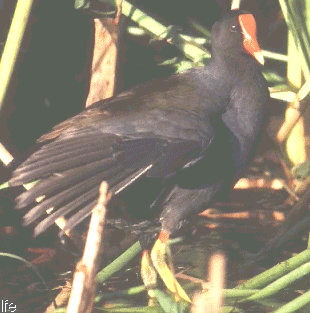 Gallinula
chloropus chloropus (Linnaeus)
Gallinula
chloropus chloropus (Linnaeus)
Moorhen
maltese: Gallozz Iswed
The Moorhen is a fairly common passage migrant in spring and autumn
with a few birds wintering at the Ghadira Nature Reserve. A few pairs have
been breeding regularly with the first breeding record being in 1984. The
Moorhen is easily recognised by the red shield on its forehead, red bill
with yellow tip and the red garter on its green legs. The body plumage
is uniform olive-brown above, dark slate colour below with white oblong
streaks on the flanks.
Order: CHARADIIFORMES
Family: LARIDAE
 Larus cachinnans
michahellis Naumann
Larus cachinnans
michahellis Naumann
Yellow-legged gull
maltese: Gawwija Prima
The Herring Gull is 55cm in length and is Malta's largest breeding
bird. It breeds in small colonies along the southern and western
sea-cliffs of Malta and Goze and on Filfla. Sexes are similar with
light grey on the mantle and wings. The latter have black tips with white
spots. The rest of the body is pure white. The stout bill is yellow
and has a red spot near the tip. The legs are yellow. The pairs that
breed here are resident. However, larger numbers visit us during
strong winds. Courtship starts in February and the crude loosely woven
nest is constructed of seaweed, straw, twigs and roots. It is built among
some vegetation on the ledge of a sea-cliff. Two to three eggs are
laid. These are of an olive-grey colour heavily blotched with shades of
dark brown. Incubation is shared by both sexes and takes about four
weeks. The chicks are at first covered in yellowish down with brownish
spots on the back. They are active soon after hatching but take about
five weeks to fly. They are then of a streaky brownish colour.
The immature birds take about four years to reach adult plumage. The food
of the Herring Gull Consists of marine organisms as well as offal and carrion.
Order: STRIGIFORMES
Family: TYTONIDAE
 Tyto
alba (Scopoli)
Tyto
alba (Scopoli)
Barn Owl
maltese: Barbagann
The Barn Owl (34cm) has white underparts, a heart-shape facial disc
and pale golden buff upperparts with large pale grey markings. It
has long, feathered legs and strong claws which secure its prey. Its prey
consists mainly of rats and mice which it hunts at night. A few pairs are
resident. Unfortunately the Barn Owl is shot for stuffing purposes and
is in danger of being exterminated from our Islands. The last recorded
breeding pair was shot in 1988. Other single bird sightings have been since
recorded but breeding has not been confirmed. The nesting site is usually
a deep crevice in a cliff or bastion. Breeding commences in April and continues
well into Summer. Two to four white, round eggs are laid on bare ground
in the crevice which is littered with the pellets which the Barn Owl regurgitates
after each meal. The nestlings are at first covered in white down. Both
parents feed the young at night. When they leave the nest after weeks
they resemble the adults.
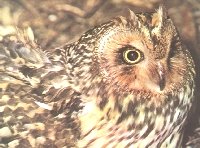 Asio flammeus
flammeus
Asio flammeus
flammeus
Short-eared owl
maltese: Omm is-subien, kokka tax-Xaghri
This owl may be distinguished by its large size (37 cm length) and
exceptionally long wings. Ground colour varies from cream or buff to pale
rufous, the feathers being profusely mottled with black or dark brown with
pale fringes. There are large white spots on the outer web of the greater
wing-coverts. Facial disc is dirty white or buff, the eye bordered with
black. The bird, a migrant to Malta, has on rare occasions (1909 and 1983)
actually bred in the island.
Order: COLUMBIFORMES
Family: COLUMBIDAE
 Streptopelia
turtur
Streptopelia
turtur
Turtle Dove
maltese: Gamiema
The Turtle Dove is one of the best known migrants both north and
south of the Mediterranean and literally thousands are netted or shot on
their passage in all the countries bordering the sea, including Malta.
This species is a small slenderly-built dove (27 cm). The upperparts are
rust-coloured with black middles to the feathers. Forehead pale grey, crown
ashy, nape browner. Nech, throat and breast are pinkish-vinous. A patch
of black and white feathers are found on each side of the neck. It has
beenreported to very rarely breed from time to time in Gozo and also in
captivity.
Order: PASSERIFORMES
Family: ALUDIDAE
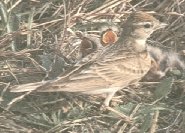 Calandrella
cinera brachydactyla (Leiser)
Calandrella
cinera brachydactyla (Leiser)
Short-toed Lark
maltese: Bilbla
The Short-toed Lark (14 cm) is a small, streaked, sandy-brown lark
with clear white underparts. It has a blackish spot on each side of the
breast. It is a summer breeding visitor to Malta, arriving from late March
and remaining until late September. During this time it frequently soars
high up in the air from where it sings for long periods. The Short-toed
Lark breeds in open rocky areas, airfields as well as cultivated fields.
Nest building commences in late April. The nest is a scantily lined depression
in the ground usually in the shelter of a small plant or stone. It is built
of fine roots and grasses. Four eggs are usually laid. These are of creamy-white
colour speckled and clouded with various shades of brown and grey. Incubation
averages thirteen days, and two broods are generally reared in a season.
The young leave the nest after about 10 days but are still unable to fly
any distance and are cared for by the parents for a few more days.
Family: HIRUNDINIDAE
Hirundo rustica rustica
European Swallow
maltese: Huttafa
The common European Swallow is a very familiar spring and autumn
migrant with dark glossy blue upperparts and wings, a chestnut throat,
and white to buff underparts with blue breast-band, a forked tail with
long outer feathers and adorned with white mirrors conspicuous when open.
A pair have been reported to breed on the islands in 1974.
 Delichon
urbica urbica
Delichon
urbica urbica
House Martin
maltese: Hawwiefa
The House Martin is a very common vistor during spring and a scarce
visitor in autumn. The pure white underparts from chin to under tail-coverts
and the white rump distinguish the species from the other swallows. The
rest of the body plumage is deep glossy blue, the wings are blackish-brown.
The faintly glossed blue blackish tail is forked. The House Martin is a
breeding bird over the whole of Europe, but very rarely breeds on the Islands
with three occasions being recorded, the first time in 1981.
Oenanthe hispanica
Black-eared Wheatear
maltese: Kuda dumnikana
The Black-eared Wheatear has two varieties, one with a black throat
as well as ears, the other black ears only. The crown and back are a warm
cinnamon bluff. The wings are black, the underparts suffused with cinnamon.
A pair have been recorded to breed in 1982.
Family: TURDIDAE
Monticola solitarius (Linnaeus)
Blue Rock Thrush
maltese: Merill
The Blue Rock Thrush is about 20 cm in length. The male's plumage
is deep blue with blackish wings and tail, while the female is brownish
grey finely barred underneath. The male is well known for its melodious
song. It is resident and inhabits sea-cliffs, rocky hill-sides and rocky
valleys. An untidy nest of roots and fine twigs is built in a hole or crag
in the rocks, or in bastions as well as in remote disused buildings. Usually
two broods are raised in a season. The eggs are laid about late March and
number four to six, usually five. They are of a pale bluish colour usually
with fine reddish brown spots round the larger end. Incubation and nestling
period takes about 30 days. Only the female incubated the eggs, but both
birds feed the young. The food consists mainly of grasshoppers, worms,
beetles and small lizards. Unfortunately, though protected by law, some
people still persst in stealing the young from the nest to raise in captivity.
The Blue Rock Thrush is the national bird of Malta and the emblem of the
Ornithological Society.
Family: SYLVIDAE
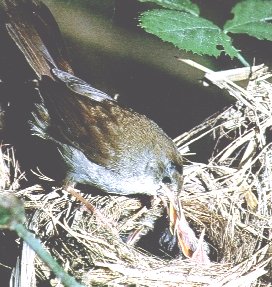 Cettia
cetti (Temminck)
Cettia
cetti (Temminck)
Cetti's Warbler
maltese: Baghal ta' l-Gholliq
The Cetti's Warbler (13.5 cm) has dark rufous-brown upperparts,
a greyish white throat and belly and light brown breast and flanks. Its
ten-feathered tail is much rounded. It is a difficult bird to spot as it
skulks in thick vegetation but makes its presence felt with irs loud and
striking song. The Cetti's Warbler has started breeding in Malta in the
past 30-35 years and though it is far from being common, it is found in
suitable areas such as overgrown valleys. The nest is usually built under
a canopy of thick vegetation usually in bramble thickets. It is lossely
constructed from dry grasses and reed blades, lined neatly from the inside
with fine grasses and feathers. Two to five eggs are laid in April. These
are of a brick-red colour. Nest building and incubation are carried out
by the female while the male patrols the area. Two broods are usually raised
in one season. Incubation and nestling period takes about 30 days. The
young are fed for several days after they leave the nest. During this period
they learn how to find food by observing their parents. Such behaviour
is common to many other species, with exceptions such as shearwaters and
petrels.
Arcocephalus scirpaceua scirpaceua
Reed Warbler
maltese: Baghal tal-qasab
The reed Warbler is a small plain-backed with brown upperparts,
paler on the rump. The underparts are dull white washed with buff on the
sides and flanks. The species is scarce during spring and common in autumn.
It has rarely been noted to breed on the Maltese Isalands.
Sylivia conspicillata Temminck
Spectacled Warbler
maltese: Bufula Hamra
The Spectacled Warbler (12 cm) can be met with all through the year
like the Sardinian Warbler. It has brownish upperparts with bright chestnut
on the wings. The male has a richer grey head with dark lores. The throat
is white as are the underparts, but the male has a pinkish suffusion on
the breast. The Spectacled Warbler prefers the open countryside. During
the courting period, the male indulges frequently in song flights like
the Sardinian Warbler. The nest which is built in a low shrub or thistle
is usually within 30 cm off the ground. It is small and deeply cup-shaped,
consisting of fine grasses, lined from the inside with vegetable down or
horse hair. The eggs number three to five, usually four to five. They are
of a greenish white colour, thickly speckled with olive-brown and grey,
sometimes formingf a zone at the larger end. The incubation and nestling
period takes about 24 days, both parents sharing the duties. Usually two
broods are reared in a season.
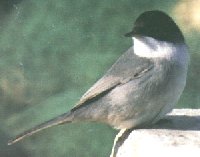 Sylivia
melanocephala
Sylivia
melanocephala
Sardinian Warbler
maltese: Bufula Sewda
The Sardinian Warbler (13 cm) is a greyish bird. The male has a
glossy jet-black head. The female is browner with a greyhead. Both have
a white throat, a reddish eye-ring and a broad rounded tail with white
outer feathers. The Sardinian Warbler is widespread and is found in all
types of Maltese countryside as well as in gardens in urban areas. The
nest which may be built in a low shrub or tree is usually within a metre
off the ground though occasionally it may be higher. It is cup-shaped and
neat, and built of dry grasses and dry leaves and lined on the inside with
vegetable down, fine roots and hair. Two to five eggs are laid. As in many
other species the colour of the egg is variable. Usually, they are of greenish
white colour speckled with orange-brown, very often foring a zone round
the thicker end. Incubation, which is carried out by both sexes, lasts
about 12 days. Both parents feed the young which leave the nest after about
another 12 days. Two, sometimes three, broods are reared in a season.
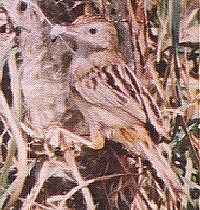 Cistocola
juncidis juncidis
Cistocola
juncidis juncidis
Fan-tailed Warbler
maltese: Baghal ta' l-Imrewha
The Fan-tailed Warbler (10 cm) is Malta's smallest bird. It is brownish
above, paler below. The upper parts are heavily streaked except for its
rufous rump. It has a short rounded tail with the feathers having black
and white tips except the central pair. The male frequently patrols the
breeding area flying high above, uttering incessantly a series of "zip-zip"
calls. This attracts the attention of the observer, otherwise the bird
is quite inconspicuous in its behaviour. The male may have more than one
female at the same time. The male starts by building the outer shell of
the nest which is then completed by the female. The nest is usually well
hidden, very often within 30 cm above the ground, and is built in grasses
or rushes in open countryside. The shape of the nest is like a wide-necked
bottle or an open, deep, round purse. It is neatly woven with vegetable
down, cobwebs and fine blades of dry grass. Three to six eggs are laid.
The colour is very variable and may be white or light blue with or without
any markings. Incubation and feeding of young is carried out by the female
while the male patrols the breeding area, frequently chasing away other
birds. Incubation and nestling period lasts about 28 days and three broods
may be raised in one season. The first breeding observation of the Fan-tailed
Warbler was in Xemxija and Ghadira in 1973. In such a short time it is
already quite widespread and is breeding successfully.
Family: MUSCICPIDAE
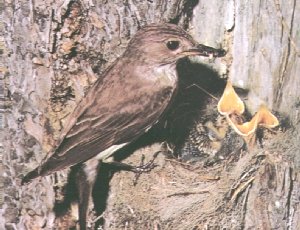 Muscicapa
striata (Pallas)
Muscicapa
striata (Pallas)
Spotted Flycatcher
maltese: Zanzarell tat-Tikki
The adult Spoted flycatcher is uniform hair-brown except for the
crown which is streaked. The underparts are white washed with pale brown
on the breast and flanks. The throat is white streaked with brown. Wings
and tail are brown. The first authentic nesting attempt in Buskett was
recorded in 1971. The nest is made up of a loose and flimsy construction
which hardly cups the young.
Family: LANIIDAE
Lanius senator Linnaeus
Woodchat Shrike
maltese: Kaccamendula
The Woodchat Shrike (17 cm) has a rufous-chestnut crown and nape.
Its forehead, cheeks, back wings and long tail are black. It has white
shoulder patches, wing-bars, rump and sides of tail. Its throat and breast
are shining white. It is a spring and autumn migrant but a very few pairs
remain to breed. The compact cup-shaped nest is neatly built with fine
roots and twigs lined with vegetable down in a leafy treetop, generally
higher than 2.5 metres. About five eggs are laid in May or June. They are
of a pale greenish colour with greyish brown markings, but as in many other
species, egg colour may vary. Incubaton and nestling period takes about
35 days. When the young leave the nest they do not have the attractive
black and white pattern of the adults and are pale greyish-brown with lighter
underparts. The Woodchat Shrike likes to perch on tops of trees and on
wires from where it watches the ground for beetles, grasshoppers and small
lizards.
Family: PASSERIDAE
 Passer
hispaniolensis
Passer
hispaniolensis
Spanish Sparrow
maltese: Ghamiel tal-Bejt
The Spanish Sparrow (14.5 cm) needs no introduction. It is abundant
and breeds in holes in buildings, cliffs, electricity pylons and trees.
The male has a deep chestnut head, a black bib and breast, and black streaks
on flanks and back. On the shoulders, it has a chestnut patch and a short
white stripe. The female is rather dull and featureless, earthbrown in
colour and paler beneath, with a streaky back. The nest is bulky and may
include hay, straw, grass, paper, wool, hair, feathers and even small rags.
The inside is always lined with soft feathers and vegetable down. Four
to six eggs, usually five, are laid in March. These vary in colour, havinga
white or bluish white ground colour with spots, freckles or blotches of
dark greyish or reddish brown. Incubation is chiefly carried out by the
feale, but after the young hatch the male helps in the feeding. Incubation
and nestling period may take about 8 days. Up to four broods may be reared
in one season.
Passer montanus (Linnaeus)
Tree Sparrow
maltese: Ghammiel tas-Sigar
The Tree Sparrow (13.5 c) is less known and familiar than the Spanish
Sparrow because it is rather a shy bird. It is smaller and more slender.
It has a black spot on the white earcoverts and its crown is chocolate
brown. Sexes are similar. Few scattered pairs and small colonies breed
in various parts of the islands, and are found all the year round, but
passages also occur in autumn. The tree Sparrow breeds in rural as well
as in suburban areas referring narrow crags and holes in buildings and
walls. The bulky nests which we see in high trees are those of the Spanish
Sparrow and not of the Tree Sparrow. Four to six eggs are laid in April
as a general rule; however two to three broods may be reared in a season.
The eggs which are light brown, are covered with dark markings. The food
is similar to that of the Spanish Sparrow and may consist of seeds as well
as insects, grubs, caterpillars and spiders.
Family: FRINGILLIDAE
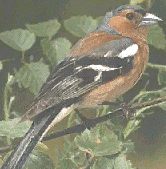 Fringilla
coelebs Linnaeus
Fringilla
coelebs Linnaeus
Chaffinch
maltese: Sponsun
The male Chaffinch has a black forehead, crown and nape bluish-grey
passing on to reddish brownalmost rufous-chestnut on te mantle and back.
The rump is olive green, cheeks, throat and underparts brownish pink. Wings
are black with white shoulder patches and a whitish wing-bar across the
wing and outer tail feathers. A common autumn visitor, but some remain
to winter until March. A few pairs breed annually mainly at Buskett
Serinus serinus (Linnaeus)
Serin
maltese: Apparell
The serin in easily recognised by its lemon-yellow rump which is
easily recognised in flight. The forehead and nape are yellow, the rest
of the upperparts are pale brown streaked with sepia. The wings and tail
are dark brown, the throat and breast lemon-yellow, the belly white. The
Serin occurs throughout southern Europe as a breeding bird, and is seen
in Malta during its migration in autumn and again in spring. A few
pairs breed annually mainly at Buskett
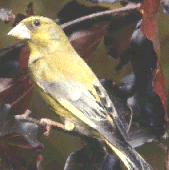 Carduellis
chloris (Linnaeus)
Carduellis
chloris (Linnaeus)
Greenfinch
maltese: Verdun
The Greenfinch has uniform and pure bright yellowish-green without
any trace of brown upperparts. The underparts are also much brighter. It
is an autumn and spring migrant, and has rarely been noted to breed in
Malta.
Carduellis cannabina (Linnaeus)
Linnet
maltese: Gojjin
The Linnet (13 cm) is a handsome finch with a streaked brownish
head and chestnut-brown mantle. The male has a crimson forehead and breast
in spring. The female is more streaked. Large numbers pass in autumn. Some
also stay with us during the winter and it repasses again in Spring. Small
numbers are resident in Malta, but mainly in Gozo. These usually build
their nests in carob, citrus and almond tress but also in overhanging bushy
plants on steep slopes or cliffs. The bulky cup-shaped nest is made of
ine grasses and roots lined with hair and vegetable down, and can vary
in height from one to four metres above the ground. Four to six eggs are
usually laid in March. They are greyish white finely blotched with red
and mauve. These are incubated by the feamle for about 12 days and the
young remain in the nest for about 11 days. Two broods are generally reared
in a season.
Carduelis carduelis
Goldfinch
maltese: Gardell
The Goldfinch is a regular bird of passage through the Islands.
The bright colour of the Goldfinch enable it to be quickly recognised.
A crimson mask bordered with white contrasts with the black on the crown
and sides of the neck. The undersides is white washed with brown on the
flanks. It very rarely (1913 and 1966) breeds on the Islands.
Family: EMBERIZIDAE
Miliaria calandra (Linnaeus)
Corn Bunting
maltese: Durrajsa
The Corn Bunting (17.5 cm) is a resident as well as a partial migrant.
It is a rather featureless bird, being pale olive-brown with darker streaks.
Sexes are similar. It breeds in fairly open countryside and starts nest-building
in February. The nest is fairly large and is neatly built on the ground
amongst the herbbage as well as in low vegetation. It is constructed of
roots and dry grasses generally lined with finer grasses, roots and hair.
The eggs, four to six, are purplish white, blotched, speckled or scrawled
with purple, black and brown spots and lines. The female incubates the
eggs for about 12 days and the young leave the nest after about 10 days
- before they can fly. Males are sometimes polygamous.